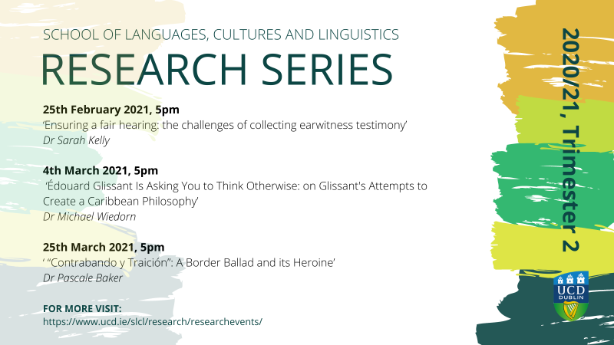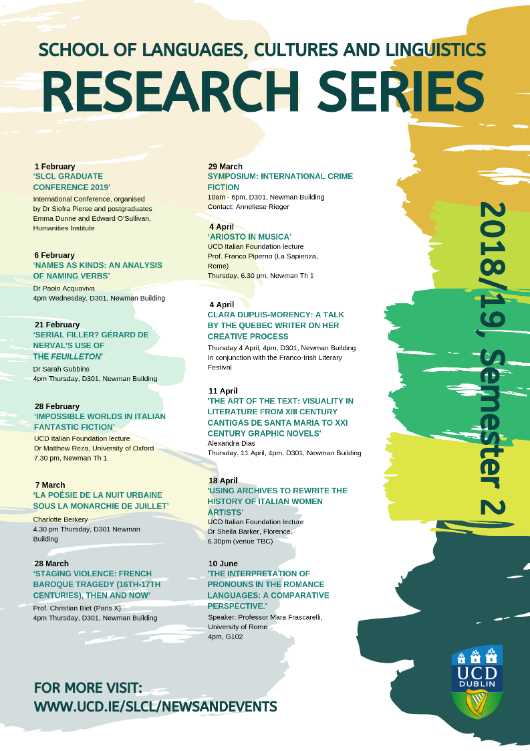2024/25 Research Events
Matthew Hilborn (UCD), Thursday, 6th March at 3 pm, D301
“It doesn’t move me like you move me”: Romance, Dating Apps, and Hybrid Intimacies in Spanish Romantic Comedies on Netflix
This paper examines the interplay of physical and digital intimacies in contemporary Spanish romantic comedies on Netflix, focusing predominantly on the LGBTQ+ series Smiley (2022–) and the heterosexual love story I Love You, Stupid (Laura Mañá, 2020). Situating their portrayals of app-mediated dating within broader debates on the platformisation of both affect (Van Dijck et al. 2018) and romcom itself -- following the romantic comedy’s global “renaissance” (Wilkinson 2023, Idle 2024) on streaming platforms - it explores how these works navigate onscreen tensions between somatic and cyber-mediated romance.
Through split-screen editing, parallel narration, and diegetic emoji use, both works visualise the barriers and resolutions in modern relationships, portraying new “hybrid ecologies” of dating (Licoppe et al. 2016). However, rather than affirming data-driven, algorithmic matching as a “digital fix” for romantic "messiness" (Bandinelli & Gandini 2022), these romcoms critique the online marketisation and quantification of relationships, which reframe partners as self-optimising entrepreneurs.
While these narratives reflect broader “post-romantic” shifts in screen media (San Filippo 2021) and the erosion of “couple confidence” (Harrod, Leonard & Negra 2021), this paper argues that they ultimately reaffirm conventional ideals of monogamy, stability, and long-term commitment as the (only) “good life” (Ahmed 2006, 2010). Their simultaneous embrace of digital "relationshopping" (Heino et al. 2018) and ambivalence toward casual, non-exclusive encounters reveals a complex negotiation between contemporary dating cultures and enduring romcom tropes, illuminating the ambivalent dimensions of Netflix's reinvention of the genre.
Katherine Brown (UCD), Tuesday 1st April at 3 pm, D301
Architecture and Madness in Miguel de Cervantes’ Don Quixote
The eponymous protagonist of Miguel de Cervantes’ Don Quixote (1605 and 1615) is perhaps most well-known for his madness-induced exploits on the open road. While critics have largely interpreted architectural spaces in the novel as antidotes to Don Quixote’s insanity, placing physical limits on his imagination and ability to impose the codes of chivalric fiction onto his reality, I argue that architecture in fact serves as one of the most potent representations of Don Quixote’s madness in the novel. I suggest that Cervantes subverts classical and Renaissance-era understandings of architecture as both a symbol of rationality and a discipline that imposes logical organisation onto physical spaces. He instead attributes metaphorical architectural features (doors, rooms, and attics) to Don Quixote’s insanity itself and inscribes those features onto several of the novel’s physical spaces, thus extending the mechanisms of madness beyond Don Quixote’s own experience and perception of reality. Through an examination of a selection of these metaphorical and literal architectures, I conclude that Cervantes repurposes architectural language to accommodate the unconventional worldview of his protagonist and to probe the effects of Don Quixote’s madness on the supposedly “rational” world around him.
The Myth of the Mad Organist in 19th-century French Literature (and beyond)
The myth of the “mad” organist illustrated by, amongst others, Jules Verne in Twenty Thousand Leagues under the Sea and Gaston Leroux in The Phantom of the Opera, grew out of a change in the social and religious roles of the pipe organ in 19th-century France. In a study of 35 works of French literature written between 1830 and 1910 it has been interesting to analyze this development in the context of the technical modifications realized by organ builders such as Aristide Cavaillé-Coll (1811-99) that enabled the organ to rival the symphony orchestra and to become a truly Romantic instrument. Looking forward to the present day, we see this same myth illustrated in contemporary popular film, computer games and anime, and a revival of the pipe organ's use outside the sacred context.
Violence, Victims, and Heroes: Early Canadian and Irish Plays about World War II
Plays about WWII, as cultural representations of violence, weave their way deeply into society. They shape how we see the events, identify with them, and make sense of them. Furthermore, narratives of war change and transform in relation to shifting cultural, political, economic, historical, and national priorities of the moment. Theatre, both ephemeral and live, is especially pertinent when interrogating memories of and societal connections to WWII. Through play recovery, analysis, and historicization, I will investigate how WWII was dramatized in the decades immediately following the end of the conflict. Plays about WWII in its aftermath received little attention, especially when they diverged from the heroic, Manichean narratives of good and evil that dominated politically and in the media. I will begin to unveil these overlooked texts and consider how they rehabilitate our understanding of cultural and societal formulations of WWII. What stories are told/silenced/forgotten? How are key events depicted? How are “heroes,” “victims,” and “enemies” portrayed and mythologized? Plays are “as much a comment on the playwright’s own times as on the periods about which they are ostensibly written” (Lindenberger, 1975, 5). Therefore, how do these plays represent discourses of the post-war period? How do they interact with WWII historiography? Important themes for analysis include survival and/vs. devastation; representations of national, cultural, and political ideologies; individual and/vs. collective memory and identity; and violence, trauma, and loss.

